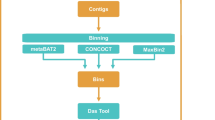Abstract
Objectives
To analyze the microbial diversity and gene content of a thermophilic cellulose-degrading consortium from hot springs in Xiamen, China using 454 pyrosequencing for discovering cellulolytic enzyme resources.
Results
A thermophilic cellulose-degrading consortium, XM70 that was isolated from a hot spring, used sugarcane bagasse as sole carbon and energy source. DNA sequencing of the XM70 sample resulted in 349,978 reads with an average read length of 380 bases, accounting for 133,896,867 bases of sequence information. The characterization of sequencing reads and assembled contigs revealed that most microbes were derived from four phyla: Geobacillus (Firmicutes), Thermus, Bacillus, and Anoxybacillus. Twenty-eight homologous genes belonging to 15 glycoside hydrolase families were detected, including several cellulase genes. A novel hot spring metagenome-derived thermophilic cellulase was expressed and characterized.
Conclusions
The application value of thermostable sugarcane bagasse-degrading enzymes is shown for production of cellulosic biofuel. The practical power of using a short-read-based metagenomic approach for harvesting novel microbial genes is also demonstrated.




Similar content being viewed by others
References
Ando S, Ishikawa K, Ishida H, Kawarabayasi Y, Kikuchi H, Kosugi Y (1999) Thermostable aminopeptidase from Pyrococcus horikoshii. FEBS Lett 447:25–28
Bae HJ, Turcotte G, Chamberland H, Karita S, Vézina LP (2003) A comparative study between an endoglucanase IV and its fused protein complex Cel5-CBM6. FEMS Microbiol Lett 227:175–181
Blumer-Schuette SE, Kataeva I, Westpheling J, Adams MW, Kelly RM (2008) Extremely thermophilic microorganisms for biomass conversion: status and prospects. Curr Opin Biotechnol 19:210–217
Deswal D, Khasa YP, Kuhad RC (2011) Optimization of cellulase production by a brown rot fungus Fomitopsis sp. RCK2010 under solid state fermentation. Bioresour Technol 102:6065–6072
Duan CJ, Feng JX (2010) Mining metagenomes for novel cellulase genes. Biotechnol Lett 32:1765–1775
Dutoit R, Brandt N, Legrain C, Bauvois C (2012) Functional characterization of two M42 aminopeptidases erroneously annotated as cellulases. PLoS One 7:154–159
Forterre P (2002) A hot story from comparative genomics: reverse gyrase is the only hyperthermophile-specific protein. Trends Genet 18:236–238
Ghose TK (1987) Measurement of cellulase activities. Pure Appl Chem 59:257–268
Huson DH, Auch AF, Qi J, Schuster SC (2007) MEGAN analysis of metagenomic data. Genome Res 17:377–386
Kaushik JK, Bhat R (2003) Why is trehalose an exceptional protein stabilizer? An analysis of the thermal stability of proteins in the presence of the compatible osmolyte trehalose. J Biol Chem 278:26458–26465
Kobayashi T, Romaniec MPM, Barker PJ, Gerngross UT, Demain AL (1993) Nucleotide sequence of gene celM encoding a new endoglucanase (CeIM) of Clostridium thermocellum and purification of the enzyme. J Ferment Bioeng 76:251–256
Lv Z, Yang J, Wang E, Yuan H (2008) Characterization of extracellular and substrate-bound cellulases from a mesophilic sugarcane bagasse-degrading microbial community. Proc Biochem 43:1467–1472
Okano H, Ozaki M, Kanaya E, Kim JJ, Angkawidjaja C, Koga Y, Kanaya S (2014) Structure and stability of metagenome-derived glycoside hydrolase family 12 cellulase (LC-CelA) a homolog of Cel12A from Rhodothermus marinus. FEBS Open Biol 4:936–946
Syn CKC, Swarup S (2000) A scalable protocol for the isolation of large-sized genomic DNA within an hour from several bacteria. Anal Biochem 278:86–90
Takami H, Takaki Y, Chee GJ, Nishi S, Shimamura S, Suzuki H, Matsui S, Uchiyama I (2004) Thermoadaptation trait revealed by the genome sequence of thermophilic Geobacillus kaustophilus. Nucleic Acid Res 32:6292–6303
Tatusov RL, Galperin MY, Natale DA, Koonin EV (2000) The COG database: a tool for genome-scale analysis of protein functions and evolution. Nucleic Acid Res 28:33–36
You RJ, Shin HY, Yoo HY, Um Y, Kim SW (2012) Production of cellulases and β-glucosidase in Trichoderma reesei mutated by proton beam irradiation. Korean J Chem Eng 29:925–930
Acknowledgments
This work was financially supported by the National Natural Science Foundation of China (41306181) and Science Foundation of the Fujian Province, China (2016J06009 & JK2014014). The project was also supported by FAFU grants XJQ201417 and 612014043.
Supporting information
Supplementary Table 1—Homologous genes classified in glycoside hydrolase (GH) families (identity >80 %) from XM70.
Supplementary Table 2—Identities between protein sequence of XM70-cellulase with the several predicted cellulase and peptidase amino acids sequences.
Supplementary Table 3—Similarities between protein sequence of XM70-cellulase with the several predicted cellulase and peptidase amino acids sequences.
Supplementary Fig. 1—Scanning electron micrographs of the sugarcane bagasse. (a) Un-degraded sugarcane bagasse. (b) Surface of the degraded sugarcane bagasse with holes.
Supplementary Fig. 2—Glycoside hydrolase gene families’ distribution. The percentage was calculated according to the contigs aligned number percentage in different GH families. Contigs shared more than 80 % identity with the hit gene.
Supplementary Fig. 3—The protein sequence of XM70- cellulase hit the M42_Frv domain, which is annotated as the “M42 Peptidase, Endoglucanases; Peptidase M42 family, Frv subfamily (cd05656, M42 Peptidase, Endoglucanases)”.
Author information
Authors and Affiliations
Corresponding author
Electronic supplementary material
Below is the link to the electronic supplementary material.
Rights and permissions
About this article
Cite this article
Zhao, C., Chu, Y., Li, Y. et al. High-throughput pyrosequencing used for the discovery of a novel cellulase from a thermophilic cellulose-degrading microbial consortium. Biotechnol Lett 39, 123–131 (2017). https://doi.org/10.1007/s10529-016-2224-y
Received:
Accepted:
Published:
Issue Date:
DOI: https://doi.org/10.1007/s10529-016-2224-y




